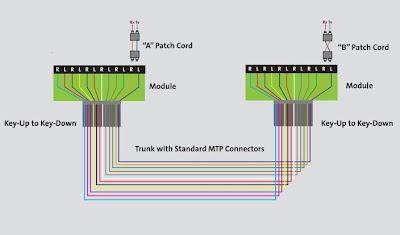Friday, December 4, 2015
Introduction to your MTP fiber optic cable polarity wiring
If your getting into MTP cables you need to know what type of polarity you need to configure these cables to, a good place to start is with the TIA-568-C.O standard. This standard provides guidance on serial transmission fiber polarity for fiber networks installing MTP optical connectivity. Each 12 strand MTP connector is divided into six 2 strand fiber optic serial circuits that require polarity management that can be achieved using one of a few methods.
I'm going to start you out with what so far seems to be the most popular polarity pinout, this would be the "Universal Polarity Management Method" and is used in many Corning fiber networks. It seems to be a little odd that this would be the most popular so far because the universal method is not included in the TIA standard but it does meets the "intent of the standard" that's according to Corning. Makes good sense that this would be most popular because Corning seems to be the biggest giant in the fiber optic cable market.
This system is mated key-up to key-down. This method supports simple concatenation of multiple trunks without effecting polarity. Accommodates all simplex/duplex connector types. The components related to your MTP connector will also allow for easy moves without polarity concerns used in other methods.
The next most common polarity pinout method I see is "Method B". This uses a single module type wired in a straight-through configuration and standard patch cords on each end. One thing that will stand out to you is how all the components in the system are key-up to key-up. This method will require more planning for your modules location. This method also does not accommodate angle polished single mode connectors. It's also a common method in Commscope fiber optic network infrastructures.
Now thinking about it, the next method is not far behind after looking at my sales history of MTP cables. Let's talk about "Method A". This uses a single type wired in a "Straight-Through" configuration and two different patch cords in a optical circuit. One cord is straight and the other is flipped. All components in the channel are mated key-up to key-down. Because the polarity is addressed in the patch cords the end user is responsible for managing the network.
The last method I'm going to brush on is "Method C". This uses a pair wise fiber flip in the trunk cable to correct for polarity. This will enable the use of the same module on both ends of the channel and standard patch cables. Because the polarity is managed in the trunk, extending links requires more planning to maintain polarity. The TIA standard does not mention text regarding the ability to migrate to parallel optics, but parallel optics capability can easily be achieved with a special patch cord to reverse the pair-wise fiber flips in the trunk.
Now that you have a better under standing of what polarity you might need I'll be waiting for your phone call when your ready to order these! 888-797-3697 ex. 232
"By Mercy Salinas"
I'm going to start you out with what so far seems to be the most popular polarity pinout, this would be the "Universal Polarity Management Method" and is used in many Corning fiber networks. It seems to be a little odd that this would be the most popular so far because the universal method is not included in the TIA standard but it does meets the "intent of the standard" that's according to Corning. Makes good sense that this would be most popular because Corning seems to be the biggest giant in the fiber optic cable market.
This system is mated key-up to key-down. This method supports simple concatenation of multiple trunks without effecting polarity. Accommodates all simplex/duplex connector types. The components related to your MTP connector will also allow for easy moves without polarity concerns used in other methods.
The next most common polarity pinout method I see is "Method B". This uses a single module type wired in a straight-through configuration and standard patch cords on each end. One thing that will stand out to you is how all the components in the system are key-up to key-up. This method will require more planning for your modules location. This method also does not accommodate angle polished single mode connectors. It's also a common method in Commscope fiber optic network infrastructures.
Now thinking about it, the next method is not far behind after looking at my sales history of MTP cables. Let's talk about "Method A". This uses a single type wired in a "Straight-Through" configuration and two different patch cords in a optical circuit. One cord is straight and the other is flipped. All components in the channel are mated key-up to key-down. Because the polarity is addressed in the patch cords the end user is responsible for managing the network.
The last method I'm going to brush on is "Method C". This uses a pair wise fiber flip in the trunk cable to correct for polarity. This will enable the use of the same module on both ends of the channel and standard patch cables. Because the polarity is managed in the trunk, extending links requires more planning to maintain polarity. The TIA standard does not mention text regarding the ability to migrate to parallel optics, but parallel optics capability can easily be achieved with a special patch cord to reverse the pair-wise fiber flips in the trunk.
Now that you have a better under standing of what polarity you might need I'll be waiting for your phone call when your ready to order these! 888-797-3697 ex. 232
"By Mercy Salinas"
Labels:
fiber connector,
Introduction,
MTP,
polarity,
wiring
Location:
Anaheim, CA 92807, USA
Subscribe to:
Post Comments (Atom)





No comments:
Post a Comment